In the modern manufacturing industry, automation has become indispensable, especially in sectors like stationery production where efficiency and precision are paramount. One crucial aspect of this automation is labeling, which ensures products are accurately identified and tracked throughout the supply chain. Enter the stationery labeling machine, a versatile tool designed to streamline the labeling process for stationery items.

Working Principle
Basic Components
A stationery labeling machine typically consists of several key components: a labeling head, a conveyor system, a control panel, and a power supply. Each component plays a critical role in the machine's overall functionality.
Labeling Process
-
Feeding Mechanism: The process begins with the feeding mechanism, which supplies labels from a roll or stack. The machine is designed to handle various label sizes and materials, ensuring versatility.
-
Label Dispensing: Once the labels are fed into the machine, the labeling head activates. It uses sensors to detect the position of the product on the conveyor belt. When the product reaches the designated labeling point, the machine dispenses the label onto the product.
-
Adhesive Activation: Many labeling machines utilize heat or pressure-sensitive adhesives. The labeling head applies the label with the appropriate force, ensuring that it adheres securely to the product surface.
-
Quality Control: Advanced models are equipped with quality control systems that check for proper label placement and adhesion. If a label is misaligned or missing, the machine can automatically reject the product or alert the operator.
-
Output: After labeling, the products continue along the conveyor system, ready for packaging or distribution.
Types of Stationery Labeling Machines
Manual Labeling Machines
Manual labeling machines are operated by hand and are ideal for small-scale operations. They are cost-effective and easy to use, making them suitable for businesses with lower labeling demands.
Semi-Automatic Labeling Machines
Semi-automatic machines require some manual input but automate the labeling process significantly. Operators place the product in position, and the machine handles the labeling. This type is ideal for medium-sized businesses looking to increase efficiency without a significant investment.
Fully Automatic Labeling Machines
Fully automatic labeling machines are designed for high-volume production lines. They require minimal human intervention and can label thousands of products per hour. These machines are equipped with advanced technology, including sensors and programmable logic controllers (PLCs), to ensure precision and speed.
Applications of Stationery Labeling Machines
Food and Beverage Industry
In the food and beverage sector, labeling is essential for compliance with health regulations and providing consumers with necessary information. Stationery labeling machines are used to apply labels to bottles, jars, and packaging, ensuring that nutritional information, ingredients, and expiration dates are clearly visible.
Pharmaceutical Industry
The pharmaceutical industry relies heavily on accurate labeling for safety and compliance. Stationery labeling machines are used to label medication bottles, blister packs, and boxes, ensuring that dosage instructions and warnings are clearly communicated to consumers.
Retail and E-commerce
In retail and e-commerce, labeling machines play a crucial role in product identification and pricing. They are used to apply price tags, barcodes, and promotional labels to products, facilitating inventory management and enhancing the shopping experience.
Logistics and Shipping
Labeling machines are essential in logistics and shipping for tracking and identification purposes. They are used to label packages with shipping information, barcodes, and tracking numbers, ensuring efficient handling and delivery.
Advantages of Using Stationery Labeling Machines
Increased Efficiency
One of the primary advantages of using stationery labeling machines is the significant increase in efficiency. Automated labeling reduces the time and labor required for manual labeling, allowing businesses to focus on other critical tasks.
Improved Accuracy
Labeling machines minimize human error, ensuring that labels are applied correctly and consistently. This accuracy is vital for compliance and customer satisfaction.
Cost-Effectiveness
While the initial investment in labeling machines may be substantial, the long-term savings in labor costs and increased productivity often outweigh the costs. Businesses can achieve a quicker return on investment through enhanced efficiency.
Versatility
Stationery labeling machines can handle a wide range of products and label types, making them suitable for various industries. Their adaptability allows businesses to scale operations as needed.
Conclusion
The stationery labeling machine is a cornerstone of modern stationery production, combining advanced technology with practical functionality to revolutionize labeling processes. Its precise working principle, coupled with versatile applications across various stationery categories, underscores its value in enhancing productivity, ensuring product quality, and supporting brand identity. As technology evolves, these machines will continue to adapt, offering even greater efficiency and customization options, driving the stationery industry forward.
https://www.siciauto.com/working-principle-and-application-of-stationery-labeling-machine.html
www.siciauto.com
SICIAUTO





